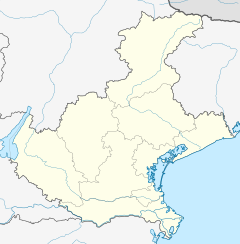Rovigo | |||||
|---|---|---|---|---|---|
 Main entrance to the passenger building. | |||||
| General information | |||||
| Location | Piazza Riconoscenza 3 45100 Rovigo Rovigo, Province of Rovigo, Veneto Italy | ||||
| Coordinates | 45°04′39″N11°46′53″E / 45.07750°N 11.78139°E | ||||
| Owned by | Rete Ferroviaria Italiana | ||||
| Operated by | Centostazioni | ||||
| Line(s) | Padova–Bologna Verona–Legnago–Rovigo Rovigo–Chioggia | ||||
| Train operators | Trenitalia | ||||
| Connections |
| ||||
| History | |||||
| Opened | 1866 | ||||
| |||||
Rovigo railway station (Italian : Stazione di Rovigo) serves the town and comune of Rovigo, in the Veneto region, northeastern Italy.
Contents
Opened in 1866, the station forms part of the Padua–Bologna railway, a double track electrified line. Rovigo is also a junction station for two other lines. Heading eastwards, towards Adria and Chioggia, is the Rovigo–Chioggia railway, a single track non-electrified line, and heading west, towards Legnago and Verona, is the Verona–Legnago–Rovigo railway, also single track and non-electrified.
The station is currently owned by Rete Ferroviaria Italiana (RFI). The commercial area of the passenger building is managed by Centostazioni. Main line train services to and from the station are operated by Trenitalia. Each of these companies is a subsidiary of Ferrovie dello Stato Italiane (FS), Italy's state-owned rail company.
Regional trains on the two branch lines are operated by a consortium of Trenitalia and Sistemi Territoriali, a public company controlled by the region of Veneto.



